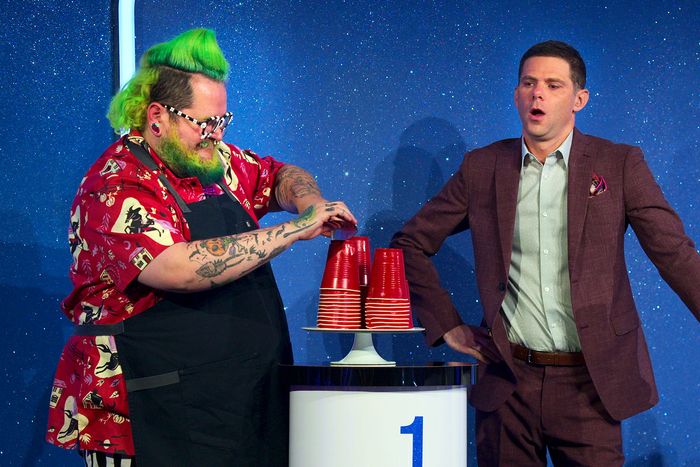
Netflix, never one to let the sleeping dog of a popular internet meme lie, has a new reality show out called Is It Cake. It’s an attempt to capitalize on the trend of cake trompe l’oeil, which has been around for many years but has really gained traction on social media, in videos where people cut into things that don’t look like cake. Guess what? They turn out to be cake.
It’s a challenging idea to transform into a reality show — there’s not a lot of there there, except to the extent that what’s there always ends up being cake. It’s so challenging, in fact, that it’s a little astonishing that this show exists, but here we are! And the Netflix show is … well, it does exist, so it’s got that going for it. It’s hosted by SNL’s Mikey Day, who has the difficult task of finding many different ways to say, “You’re never gonna believe this, but: It’s cake!” There’s a panel of judges who have to guess what objects are actually cakes, and the contestants are professional bakers who return in each episode.
In all fairness, some of the choices for how to turn this meme into a show were pretty decent. Still, it’s hard not to watch and think, I do not care about any of this. I came for one thing and one thing only: to watch people cut into something that doesn’t look like cake and reveal its inner secrets.
So much of Is It Cake is spent on something other than cutting up stuff! It didn’t have to be this way, and although this show already exists and no one will ever take this advice, I’d still like to offer up a suggestion for what Is It Cake could’ve been. The first step is getting a set, a group of regular people, a blindfold, and a knife.
The rough idea is this: An eager Is It Cake contestant, ideally cast using the same general criteria of a show like Wipeout or Supermarket Sweep, is put in a blindfold and then led into a room they have never seen before. It’s a set, prepared ahead of time, made to resemble any number of different spaces. Production could really get creative here. Maybe it’s a small space — a hotel room, sponsored by Sheraton. Maybe it’s an outdoor scene, with trees and a little water feature and a tent that’s been set up for a family camping trip. Perhaps it’s somewhere with a much larger scale, like a suburban Old Navy (sponsored by Old Navy), or a bank lobby, or maybe this is an ABC reality show and it’s a replica of the Bachelor mansion! The opportunities here are really endless.
So this excited contestant is led into the space, blindfolded. The lights are down. It’s quiet. It appears to be just a regular, unexciting art gallery, or airplane, or library. But somewhere in this setting, one of these objects … is cake. Lights flip on. A nearby studio audience begins to cheer. An enormous countdown clock begins flashing: There are 90 seconds on the clock. The host hands our contestant a knife (could also be a sword), and yells, “Find! The! Cake!” Chaos reigns.
There are several ways to adjust this rough premise, depending on which network buys this show or what audience they’re hoping to draw. One option is to turn it into a partner game, where the in-room contestants leave the blindfold on and are directed to cut random shit in their proximity depending on what their partner, viewing the scene from a distance, thinks looks the most suspicious. It could become a game about racking up points, with several cakes hidden throughout the set. Points could be deducted for everything a contestant slices that does not end up being cake. There could be a wagering portion, where each contestant is led through the scene once and then has to assign a monetary value to how certain they are that the REI kayak, for instance, is actually a cake-yak. It could be set up relay-style, where contestants on a team run willy-nilly through a Target-size set, screaming at one another from different aisles about what seems most worth attempting to slice into bite-size portions.
Essentially, the Netflix decisions for Is It Cake result in a reality show where too little time is spent cutting into things, and any adjusted version should start by addressing that problem. More frenzy. More shock. More cake, but also more opportunities to wonder if something is cake.
Sure, this is not especially practical. There are risks involved, largely relating to running around frantically trying to cut things that are not intended to be cut. And yeah, maybe there are some obstacles that would need to be overcome from a production standpoint. There’s the construction of all of these elaborate sets, for one thing. You’d also need to continually produce a large number of very convincing cakes that look like pillows or light fixtures or cash registers or Old Navy mannequins. Here, the Netflix series’s choice to make bakers be the contestants could be helpful: Like the choice to create a competition within a competition for the Project Runway models, bakers who most frequently create objects that no one identifies as cake could win their own prizes.
Is it likely that anyone will now start developing another show based on whether things are cake? No. But more than anything, Is It Cake is a valuable lesson in stopping to really sit with the choices we make in life. When you’re creating a reality show based on an internet meme with no plot or stakes or even surprise, stop and think to yourself: Is this the Is It Cake I really wish to see in the world? And if not, why not? What could make this idea better? Because the odds are good that your answer is going to be “more knives.”


